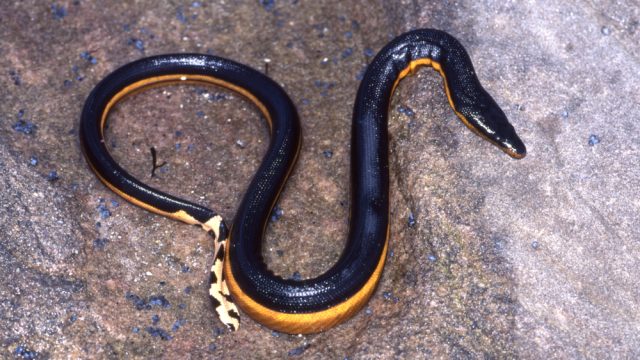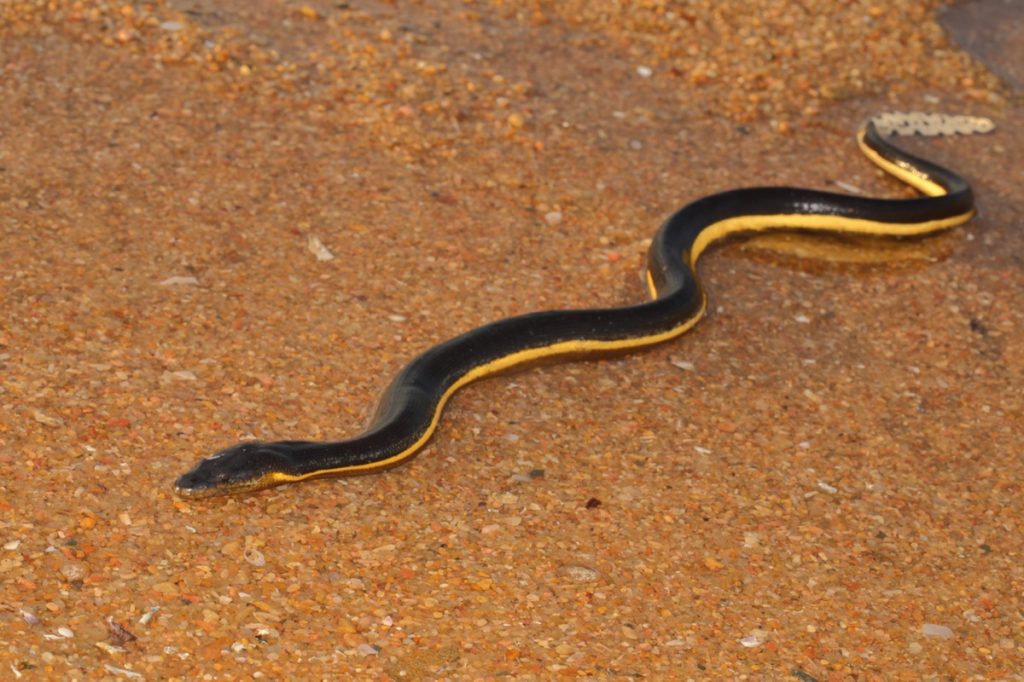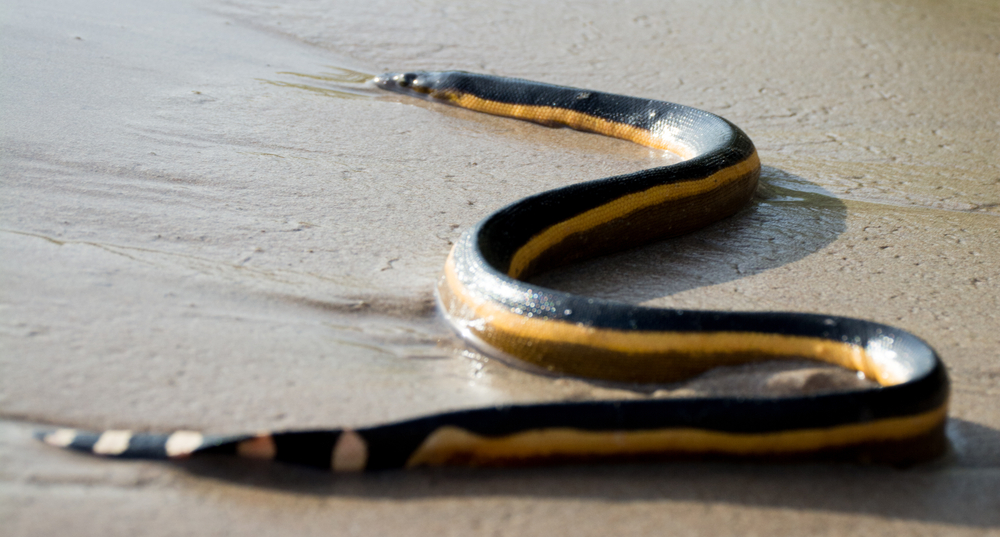Watch Out for These Venomous Snakes “Suddenly Invading,” Experts Caution

Whether you’re out enjoying nature or just spending time in your yard, there’s always a chance you’ll come across a snake no matter where you live in the U.S. Fortunately, the vast majority are completely harmless, and even those that end up being venomous pose no threat if they’re left alone. Many residents in areas where there’s a known risk of rattlesnakes, copperheads, or water moccasins are also aware of their slithering neighbors and take greater care to avoid accidentally disturbing them. But now, experts caution that there are reports of venomous snakes “suddenly invading” certain places. Read on to see which new species is making itself at home in a certain area.
READ THIS NEXT: The No. 1 Sign There’s a Snake Under Your Porch.
Climate change is shifting some species’ habitats—including snakes.

The animal kingdom is filled with a wild diversity of creatures that corner every corner of the globe. In many cases, creatures have adapted and evolved to thrive in their native habitats over millions of years. But according to experts, there are times when wildlife can end up pushing the boundaries of its typical living place.
“Most animal species, at one stage in their lives, hit the road and try to strike out on their own. This is known by scientists as dispersal,” Charles van Rees, PhD, conservation scientist and naturalist at the University of Georgia, tells Best Life. “Unless people move them around, species show up in new places because of this behavior. Sometimes they have help, for example with favorable winds or ocean currents that move them further or faster than they might travel on their own.”
However, this can also include changing temperatures due to climate change. “As humans change the environment in various ways, we can also make some areas hospitable for animals where they couldn’t have lived before,” van Rees says.
Venomous sea snakes are starting to appear in parts of the U.S.

While they may be in the front of your mind when you’re hiking or tending to your overgrown garden, snakes aren’t typically a top concern during a day at the beach. But according to experts, certain types of venomous sea snakes have begun showing up along the California Coast with increasing frequency since they were first spotted in 1972, AZ Animals reports.
“A particular species of sea snake—the yellow-bellied sea snake (Hydrophis platurus)—has started showing up with gradually increasing frequency off the coast of California in recent years,” van Rees told Best Life. “In 2015, 2016, and 2018, several were found by beachgoers on Laguna and Huntington beaches, among others, in Southern California.”
The aquatic reptile’s name doesn’t make it difficult to identify in the wild. “Yellow-bellies are fully aquatic oceanic snakes, with a dull, greenish-brown back and a bright yellow belly—hence the name—which serves as aposematic coloration, a warning to potential predators of their potent venom,” says van Rees. “Their tail is flattened and rudder-like and is creamy white with black spots. They aren’t particularly large for snakes: Males can get up to 28 inches, and females to 35 inches, so a three-footer would be a pretty large one in this species.”
Van Rees adds, “Like other sea snakes, they have extremely toxic venom, so you certainly don’t want to be bitten.”
RELATED: For more up-to-date information, sign up for our daily newsletter.
Changing conditions have brought the venomous sea snakes farther north than usual.

Experts say that the species’ nomadic nature makes them more likely to test the bounds of their traditional habitat, which is already quite expansive. “The Yellow-bellied sea snake is the most wandering snake on Earth,” says van Rees. “They occur all across the Indian and Pacific oceans—that is, from Indonesia and Japan to the West coast of Central America—and are the only sea snake to be found around Hawaii, the most isolated island chain on the planet. Part of this is because of their lifestyle: Yellow-bellies are what biologists call pelagic, which means they live in the open ocean throughout the high seas and don’t need to stick near coral reefs or other coastal structures.”
“Because of this, they’re free to live an ocean life and move around freely as long as waters are warm enough. With that in mind, it’s easy to see how and why they might start showing up further north as soon as temperatures get warm enough for them,” he explains.
According to Emily Taylor, PhD, a professor of biological science at California Polytechnic State University, San Luis Obispo and owner of Central Coast Snake Services, the species has become “notorious” since first showing up and points out that there’s always one thing in common with the sightings.
“They live in warmer waters all across the Pacific Ocean. All recorded appearances since then have taken place in El Niño years,” she tells Best Life, referencing the cyclical climate phenomenon that pushes warmer currents up against the North and South American coastlines.
Here’s what you should do if you see a yellow-bellied sea snake.

Fortunately, just like their earthbound brethren, sea snakes don’t pose an immediate safety threat so long as you take the proper precautions. “The yellow-bellied sea snake is not a danger to people if left alone,” van Rees tells Best Life. “These snakes are not known to be aggressive in the water and have small mouths and fangs that don’t make it easy to bite people,” adding that no deaths have ever been reported related to the species.
Taylor agrees that seeing more of the snakes isn’t a sign you should cancel your beach plans. “This is something that’s going to happen rarely, but it will become more common with rising sea temperatures,” she tells Best Life. “Surfers won’t be surrounded by a bunch of sea snakes: If you see one, they’ll likely see it on the beach. Most of them that wash up are cold-shocked, and they don’t survive.”
Experts also say that the best course of action when coming across a sea snake is the same as on land. “They are dangerously venomous, but they’re not a threat because they’re not going to bite you unless you go to pick one up,” Taylor says. Instead, she advises taking a picture and using it to report it to local authorities for potential identification.
Unfortunately, the snake’s appearance is likely the sign of an ultimately much bigger issue. “The real problem here is ecological,” van Rees warns, referencing the rise in worldwide sea temperatures due to climate change. “Warming oceans don’t just mean that cool tropical animals will keep coming up to visit and croaking on our beaches. Warming waters mean that a lot about our oceans is already changing, and fast. This could mean harmful algal blooms, the disappearance of beloved wildlife, crashing fisheries, or other problems. While these snakes are not going to harm anyone, they are a symptom of a much bigger change that will not do us any favors.”